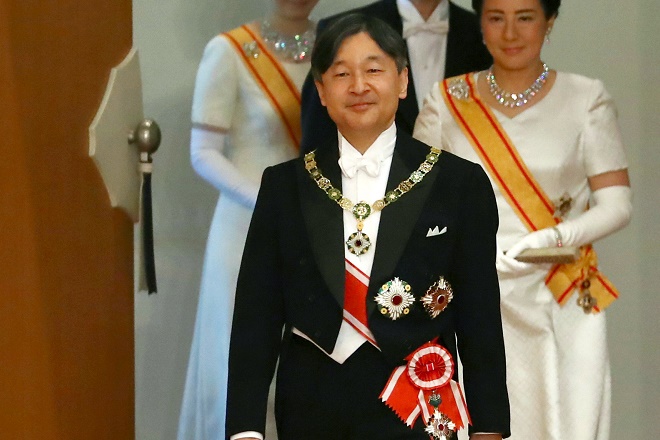Emperor Naruhito Enthroned; Reiwa Era Starts
May 1, 2019
Tokyo- New Emperor Naruhito ascended the Chrysanthemum Throne to mark the start of Japan's new era, Reiwa, on Wednesday, following his father's abdication on the previous day.
"I will act according to the constitution and fulfill my responsibility as the symbol of the state and of the unity of the people of Japan, while always turning my thoughts to the people and standing with them," the 59-year-old Emperor said in his first speech since the Imperial succession.
The first Emperor born after World War II delivered the speech during the "Sokui-go-Choken-no-Gi" ceremony, designed for him to meet the representatives of the people, at the Matsu-no-Ma state room in the Imperial Palace in central Tokyo.
Elsewhere in the speech, the new Emperor expressed his "heartfelt respect and appreciation of the comportment" as the symbol of the state shown by his father, former Emperor Akihito, now given the title of Emperor Emeritus.
Also giving a speech at the ceremony, on behalf of the people, Prime Minister Shinzo Abe said, "I'd like to pray for peace in the era of Reiwa and the prosperity of the Imperial Family."
Earlier on Wednesday morning, the new Emperor attended the "Kenji-to-Shokei-no-Gi" ceremony, in which he inherited traditional properties including the sacred sword and jewels.
At midnight Tuesday (3 p.m. GMT), Emperor Akihito, 85, abdicated the Imperial throne to mark the end of the Heisei era and Crown Prince Naruhito, his eldest son, became the 126th Emperor, according to records of the Imperial Household Agency.
It was the first Imperial succession from a living Emperor in 202 years in Japan. The abdication was enabled by the special one-time law enacted in June 2017.
Emperor Naruhito is the third Emperor to serve as "the symbol of the state and of the unity of the people," as defined by the constitution. His wife, former Crown Princess Masako, became the Empress to succeed former Empress Michiko, who was given the title of Empress Emerita after the Imperial succession.
The Kenji-to-Shokei-no-Gi ceremony, which started at 10:30 a.m. Wednesday at the Matsu-no-Ma state room, was attended by the heads of the three branches of government, including Abe, and cabinet ministers. Regional revitalization minister Satsuki Katayama, the only female member of Abe's cabinet, became the first woman in modern history to attend a Kenji-to-Shokei-no-Gi ceremony.
From the Imperial Family, only adult male members attended the ceremony, as was the case with previous Kenji-to-Shokei-no-Gi ceremonies.
The Sokui-go-Choken-no-Gi ceremony kicked off at 11:10 a.m., with the attendance of 292 people, including senior government, parliamentary and courthouse officials.
With the new Emperor's enthronement, his younger brother, Crown Prince Akishino, 53, became first in line to the Imperial throne and the Crown Prince's son, Prince Hisahito, 12, second in line.
At an extraordinary cabinet meeting that preceded the enthronement-related events, the government decided to hold the two ceremonies as "acts in matters of state" under the constitution. Jiji Press
Latest Videos
- THE UNTOLD STORY EXPERT INSIGHTS INTO THE UKRAINE
- NEGOTIATING A NEW ORDER US RUSSIA TALKS ON UKRAIN
- Ukraine: A Pawn in the Geopolitical Game? Will Trump Intervene?
- US VP VANCE CRITICIZES EUROPEAN DEMOCRACIES AT MUNICH SECURITY CONFERENCE
- UNCOVERING THE WEB OF DECEIT: CIA INFILTRATION OF THE MEDIA
- SHIFTING SANDS: TULSI GABBARD’S CONFIRMATION AND THE EVOLVING GLOBAL LANDSCAPE
- FAUCI SCANDAL: A THREAT TO GLOBAL HEALTH AND DEMOCRACY






